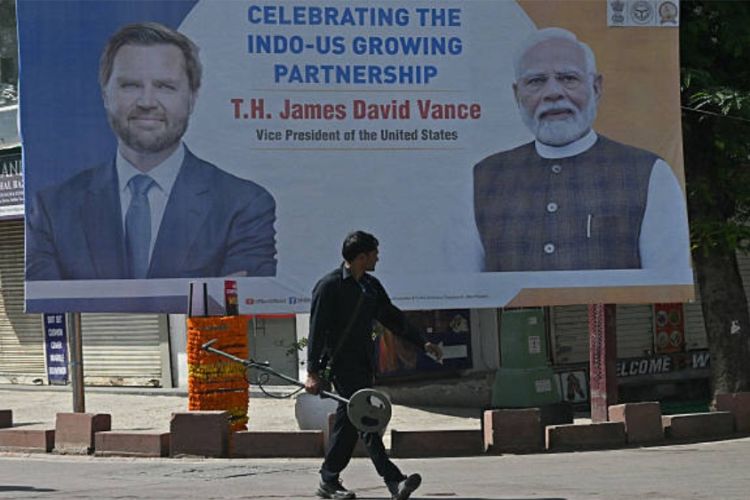As the global economy reels from the aftershocks of a renewed US-led trade war, India has moved swiftly to mitigate the fallout by pushing for a bilateral trade agreement with Washington. The two countries began formal deliberations in the US capital on Wednesday, aiming to ease trade tensions and provide businesses a degree of predictability in an increasingly volatile global environment.
The timing is critical. US Vice-President JD Vance is currently on a visit to India, coinciding with a pivotal stage in negotiations. His trip underlines the strategic weight the Biden administration—reeling from the legacy of Trump-era protectionism—attaches to bolstering economic ties with India.
READ | Europe must prepare for a NATO without America
A race against the tariff deadline
India is one of several economies racing to conclude trade deals with Washington before the expiry of a temporary 90-day pause on tariff hikes, which ends on July 9. The Trump administration had earlier slapped a 26% tariff on Indian goods, in addition to a baseline 10% tariff on all US imports starting April 5.
The bilateral trade agreement seeks to defuse this crisis. A key breakthrough came this week, with both sides finalising the terms of reference for the agreement—covering 19 chapters including tariffs, non-tariff barriers, customs facilitation, and regulatory alignment. These ToRs mark the formal beginning of what negotiators hope will be a fast-tracked process.
However, analysts caution that the emerging contours of the deal suggest it may be tilted in favour of the US, whose priority remains narrowing a $45.7 billion trade deficit with India. President Trump has repeatedly branded India the “tariff king,” a charge that has fed into his administration’s hawkish trade stance.
Market access vs strategic compromise
In an effort to meet US demands, India has already slashed duties on several goods and may consider wider concessions. But some sectors, particularly agriculture, remain non-negotiable. Washington is pressing for greater access for American dairy, tree nuts, apples, and alfalfa hay—areas India traditionally guards under its food security umbrella.
Beyond agricultural goods, US trade officials are eyeing duty cuts for petrochemical products, automobiles (especially electric vehicles), industrial goods, and wines. There is also a strong push from Washington to expand exports of energy and defence equipment to India. Earlier this week, PM Narendra Modi and Vice-President Vance discussed enhancing cooperation in defence, clean technologies, and strategic energy partnerships.
India, in turn, is seeking improved access for its labour-intensive exports—apparel, textiles, gems and jewellery, leather, plastics, and marine products. The goal is twofold: protect employment in key sectors and boost its non-oil export basket at a time when global demand remains weak.
Trade as a tool for strategic leverage
Despite the challenges, the BTA offers India several long-term strategic advantages. Chief among them is the transfer of advanced American technology in high-end manufacturing, clean energy, and defence. These align closely with India’s domestic goals of industrial transformation, energy transition, and national security enhancement.
The agreement also proposes regulatory harmonisation, digital trade protocols, and stronger enforcement of intellectual property rights—elements crucial for a transparent, rule-based trade regime. These changes are expected to enhance cross-border investment and bring stability to trade relationships.
According to a report by ACMIIL, the BTA could serve as a blueprint for India’s future trade deals with other advanced economies. If successful, it will provide a reference point for New Delhi’s trade diplomacy in an era of fragmented globalisation.
Setting the stage for a strategic reset
India and the US aim to conclude the first phase of the BTA by September or October this year. The goal is ambitious: doubling bilateral trade to $500 billion by 2030, from the current $191 billion.
India enjoys a rare trade surplus with the US, with exports rising 11.6% year-on-year to $86.5 billion in FY2024. The US accounted for nearly 20% of India’s total exports and over 6% of its imports—making it India’s most significant trading partner.
Vice-President Vance’s visit comes amid a broader diplomatic flurry. Union Finance Minister Nirmala Sitharaman is in Washington for the IMF and World Bank Spring Meetings and several G20 sessions. She is also scheduled to hold bilateral talks with counterparts from key global economies, including the United States, France, Germany, and the UK.
As the geopolitical and economic calculus shifts, the India-US BTA stands not just as a trade pact, but as a pivotal element in a strategic realignment. Whether it becomes a win-win deal or a one-sided pact will depend on how skilfully both sides navigate the road to compromise.

